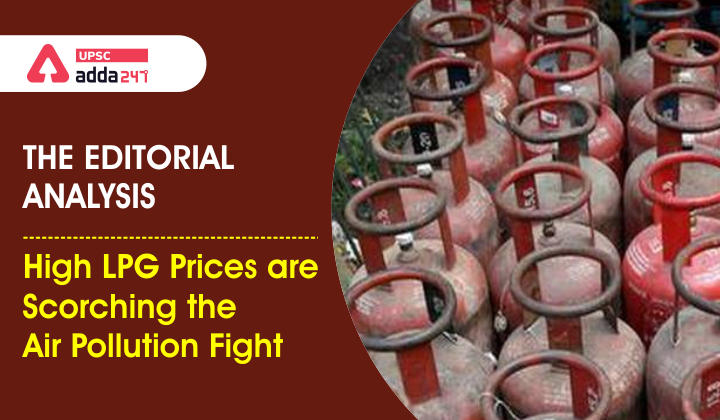Table of Contents
Increasing LPG Prices in India: Relevance
- GS 3: Infrastructure: Energy, Ports, Roads, Airports, Railways etc.
Increasing LPG Prices in India: Context
- The LPG price today has risen by more than 50% to over ₹900 per cylinder in November this year compared to around ₹600 over the past year.
- With no refill subsidies in place since May 2020, there are concerns about many households who could now go back to using polluting sources of energy, such as firewood and dung cakes.
LPG Price hike: Key points
- Solid fuel use for cooking is the leading contributor to air pollution in India.
- It is also causing related premature deaths in India, which is estimated to be around over 600,000 every year, as per the Global Burden of Disease Study 2019.
- Government has launched Pradhan Mantri Ujjwala Yojana scheme to promote cleaner fuel.
- Under this scheme, the Government distributed more than 80 million subsidised LPG connections.
LPG Price up: Success of UJJWALA
- As per the India Residential Energy Survey (IRES) 2020, conducted by the Council on Energy, Environment and Water (CEEW) and the Initiative for Sustainable Energy Policy:
- LPG has now replaced biomass as the most common cooking fuel in India.
- Nearly 85% of Indian homes have an LPG connection and 71% use it as their primary cooking fuel, compared to only 30% a decade back.
- This reversal of trends could be attributed to the success of the Ujjwala.
- This decline in the use of solid cooking fuel would have significantly influenced the sector’s contribution to air pollution.
Increasing LPG Prices in India: Present issues
- Due to high LPG prices, around 30% of Indian households continue to rely on biomass as their primary cooking fuel.
- The practice of biomass usage is predominantly concentrated in rural areas, particularly among States such as Bihar, Jharkhand, Chhattisgarh, Madhya Pradesh, Odisha and West Bengal.
- Urban slums are also critical hotspots where the use of biomass for cooking is widely prevalent.
- Moreover, easy availability of free biomass and lack of home delivery of LPG refills further reduce the efficacy of LPG as a reliable and affordable replacement of solid fuel.
Increasing LPG Prices in India: Proposed solution
Reinstate subsidies
- Reinstate the subsidies on LPG refill for low-income households.
- COVID-19 has already impacted the ability of households to afford LPG on a regular basis. Thus, resuming subsidies would be critical to support LPG use in many households.
- The Government can also explore diverse approaches to identify beneficiaries. This may include limiting the subsidy provision to seven to eight LPG refills annually and excluding well-to-do households using robust indicators.
Boost timely availability of LPG for all consumers
- Poor accessibility of LPG cylinders is a major factor behind the use of biomass among urban slum households. Moreover, only half the rural LPG users receive home delivery of LPG refills.
- There is a need to strengthen the LPG supply chain and enforce timely service delivery, particularly in States with a large number of Ujjwala connections and slum population.
- Self-Help Groups could be roped in for this cause. They will not only help aggregate demand but also create jobs in distant areas.
Create a new market for locally available biomass
- Pilot initiatives should be launched that focusses on promoting the use of locally available biomass in decentralised processing units that manufacture briquettes and pellets for industrial and commercial establishments.
- For instance, the National Thermal Power Corporation recently invited applications to supply biomass pellets to fire their power stations.
- The Government can also incentivise entrepreneurs to participate in such activities.
- Similarly, households can be incentivised to supply locally available biomass (including crop stubble or dung cakes) to Compressed Bio-Gas (CBG) production plants being set up under the Sustainable Alternative Towards Affordable Transportation (SATAT) scheme.
- Such measures would help enhance local income and livelihood opportunities, in turn encouraging rural families to use LPG on a regular basis.
Increasing LPG Prices in India: Conclusion
- The Government has recently launched the Ujjwala 2.0 scheme to distribute 10 million additional free LPG connections to poorer households.
- However, ensuring affordability and timely availability of LPG cylinders for refills would be imperative if we want that households should stay away from polluting biomass.
- Such efforts would go a long way in improving the health and well-being of our citizens.



 TSPSC Group 1 Question Paper 2024, Downl...
TSPSC Group 1 Question Paper 2024, Downl...
 TSPSC Group 1 Answer key 2024 Out, Downl...
TSPSC Group 1 Answer key 2024 Out, Downl...
 UPSC Prelims 2024 Question Paper, Downlo...
UPSC Prelims 2024 Question Paper, Downlo...




